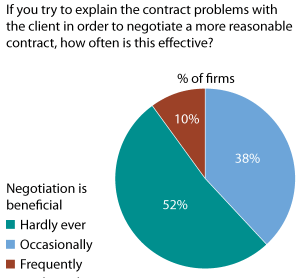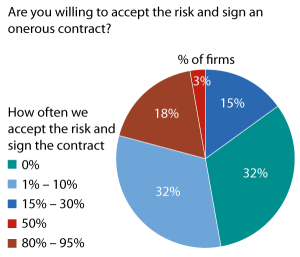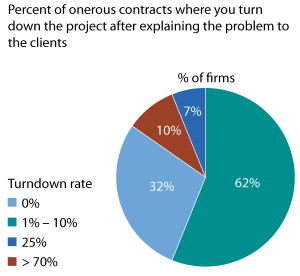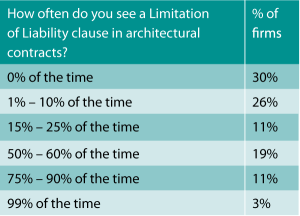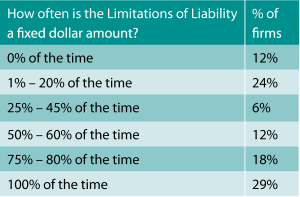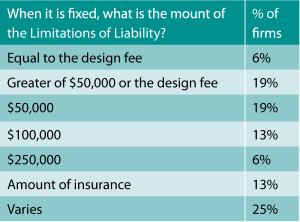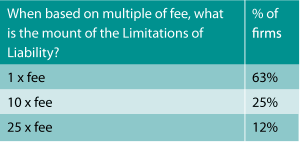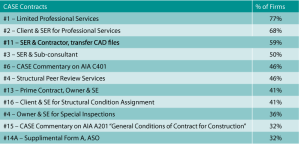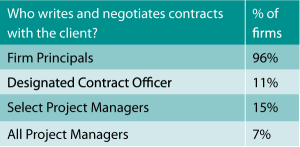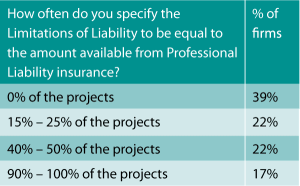Survey of SE Firms’ Contracts Practices
In preparation for a presentation on Contracts for Structural Engineers at the SEI Structures Congress last year, the presenters surveyed members of CASE to determine how they dealt with several contract issues that pose business risks to their firms. Topics included: dealing with onerous contracts, getting paid by architects even when a contract is in place, use of limitation of liability clauses, use of standardized CASE contracts, and who within a firm writes and negotiates contracts. The following are those results.
Dealing with Onerous Contracts
A big problem that structural engineering firms face is clients/owners who supply their own contracts. These contracts are typically written by the clients’ lawyers and worded to shift as much potential liability as possible for any problems away from the owner and onto the project designers and contractors, even when the owner may be the negligent party or should bear some or all of the responsibility for certain problems. Often these onerous contracts require the designers to indemnify and defend (provide the owner’s legal defense) against claims against the owner by third parties, even when the designer has not been negligent. Although many engineers believe this situation would never occur in practice, a hospital in the Midwest is currently trying to get its designers for a new building, who signed one of these onerous contracts, to defend the hospital against claims by patients who developed Legionnaires’ disease while at the hospital. These contracts also frequently require the designers to perform at the “highest quality” or guarantee a “perfect design” or “successful” project. By contrast, the professional liability insurance policies for architects and engineers only cover designers for their negligence relative to the normal standard of care. Thus, there is no insurance coverage to pay for claims based on many of these onerous contract clauses; one of these claims can easily force a design firm into bankruptcy and out of business.
The CASE survey asked members how often they were successful in negotiating a more reasonable contract after explaining the problem terms to the client. See Figure 1 for the results. Figure 2 shows how often firms are willing to sign an onerous contract when they can’t get the client to renegotiate to fairer terms.
Why do firms sign these contracts? Some of the reasons given were:
- It’s a small project with small risks.
- They need the work.
- The contact at the client’s organization says that the offending clause is required by their legal department, but not to worry, they have never sued an A/E provider.
As another example, the author’s SE firm designed some temporary shoring on a project for a large contractor on a rush basis. The contractor did not return a signed copy of the contract provided by the SE’s firm but, after the design was completed, the contractor presented an onerous contract saying it needed to be signed before the firm could be paid. The author’s firm waited until after the shoring installation was successfully completed and dismantled before agreeing to sign the contract since there was no longer any risk of a claim being made.
The responding CASE firms try to deal with these onerous contracts in the following ways:
- Always provide an industry-standard contract first.
- Explain to the client that the engineer’s professional liability policy doesn’t cover claims made under these one-sided terms.
- Do as much work as possible with repeat clients based on initial good client selection processes.
- Implement a more thorough quality control process for the project.
- Put their best project managers on the project.
- Increase the fee to cover the additional risk (which can be somewhat successful).
- Respectfully decline to submit a proposal (if the engineer knows about the onerous terms in advance).
- Put their firm in a stronger negotiating position by working as a consultant to the owner rather than as a designer contracted to the project architect.
- Keep a record of contract mark-ups and negotiation conversations to establish their inequitable bargaining position.
Payments from Architects
Getting paid in a timely manner by architect clients is a common problem for structural engineering firms. Table A shows various methods and their effectiveness in producing more prompt payment. Some of these actions can be specified in the contract with the architect.
Other methods reported by the survey respondents were:
- Refuse to sign off the completed project for the building department.
- File a lien if not paid in 90 days (this is difficult or unavailable in some states)
- Contact the architect’s client to see if the architect has been paid.
- Involve a collection agency.
- Don’t work for architects who don’t pay in a timely manner.
- Before reviewing the shop drawings or 90 days after completing the design work, whichever comes first, require the architect to sign a promissory note.
Limitation of Liability Clauses
Professional liability insurers encourage structural engineers to include a limitation of liability (LOL) clause in their contracts. Table B shows how frequently LOL clauses were used in the firms’ contracts with architects. Relative to all clients (not just architects), Table C shows how often the LOL is a fixed dollar amount and Table D shows the amount of the fixed limit.
If the client doesn’t agree to one of the lower LOL amounts, the SE can usually get them to agree to a limit on the amount of professional liability insurance proceeds available to them. Although this doesn’t do much to reduce the amount that the insurer would pay in a claim, it does keep a large claim from putting the SE’s firm out of business. When firms base the LOL on a multiple of their fee, Table E shows the multiple that firms use.
Case Contracts Most Often Used
CASE has produced 16 standard contracts for various conditions encountered by structural engineering firms. Table F shows the percentage of firms that use the more popular CASE contracts, either directly or by adopting various terms from the CASE contracts in their own contracts.
The most widely used is Contract #1, An Agreement for the Provision of Limited Professional Services, which is useful for smaller projects with a limited scope. It is a very simple and easy to use contract for most of the miscellaneous-type projects performed at an SE firm, such as adding a loading dock or adding equipment on the roof of an existing building.
Contract #2 is used when the SE contracts directly with the owner but is not the prime consultant, while Contract #13 is to be used when the project primarily involves structural work and the SE is the prime or the only consultant.
The author feels that Contract #14A, Supplemental Form A – Additional Services Order (ASO), should be used more often and should be readily available for every project manager to use. Most medium to large projects run into situations where some unanticipated structural services are required, and it is important for the SE to get paid for these. If the SE waits until the end of the project to bring these to the client’s attention, there is a high risk of not being paid for the extra work, since there is no leverage. Having a client sign the ASO before the SE does the work makes it much easier to get paid. If the SE doesn’t want to “nickel and dime” the client, he/she should send an ASO describing the additional scope of work on smaller items and indicate “No Charge”. Then after a few minor items are designed for free, if more or larger issues arise, the SE can justify finally charging for some of these.
The purpose and need for most of the listed contracts is fairly obvious; however, the importance of Contract #11 for the Transfer of CAD or BIM files should be emphasized. On most projects, the sub-contractors or fabricators want to use the SE’s CAD or BIM files to prepare their shop drawings. The SE firm exposes itself to additional risk if the terms and conditions under which the files are provided are not defined. Contract #11 makes it clear to the users of the files that they are responsible for the files once they are turned over to them. The contract also makes provisions for the SE to charge a small fee for providing the files. Although some firms have charged substantial amounts for this, CASE recommends that the charge be in line with the time necessary for a technician to prepare the files for transfer and to make the transfer. In this way, the files can still be considered “Instruments of Service” rather than a “Product” which has higher liability associated with it.
Who Writes the Contracts
Table G shows who in the firm has authority to negotiate and write contracts. As noted above regarding Additional Service Orders, the project manager must fully understand the contract so that they know when services are outside the scope for the project and an ASO should be issued. The author’s firm believes that the project manager should be the one doing most of the coordination and engineering on a project, and over 70 percent of the firm’s engineers have project manager positions or higher. The project manager will take more ownership in the success of the project if they are the one negotiating with the client, determining the scope and fee, and preparing the contract. Thus all project managers prepare at least some of their own contracts. The size and complexity, along with the project manager’s experience, will determine the level of responsibility that a project manager has in preparing the contract. The project manager’s team leader reviews all contracts and a fee committee reviews all larger or unusual projects even for the most experienced project managers and principals.
Make Up of Case Survey Respondents
Twenty seven firms responded to the CASE survey: one third of the firms had 20 or fewer employees, one third had 25 to 50 employees and one third had over 100 employees. Seventy percent of the firms were primarily structural engineers while the remainder were multi-discipline. The number of structural engineers at the participating firms ranged from one to over four hundred.
Summary
By being aware of other SE firms’ contract practices, SEs can compare their own practices relative to their peers. The results of the survey also indicate the need for NCSEA, ASCE/SEI, ACEC and CASE to work together to educate clients that they don’t have the insurance protection they thought, because their onerous contract clauses may not be covered by the designers professional liability insurance policies. Also, if SEs and other designers through their various professional associations agreed to turn down contracts with these onerous clauses, owners may realize that they can’t get good design firms to do their work. One last thing to ask the client who presents a contract with these onerous terms, “If our competitor is so ill informed about business and insurance issues that they are willing to sign this contract, what makes you think they are any more knowledgeable about good design practices? Do you really want them designing your facility?”
The contracts, guidelines and other publications developed by CASE are available for purchase. Go to www.ACEC.org, and on the right side of the page click on “Coalitions”, then scroll down and click on the CASE hyperlink labeled “Council of American Structural Engineers.” Then select “News & Resources” then “Publications” and finally “Contract Documents”. All publications are free to CASE members.▪

